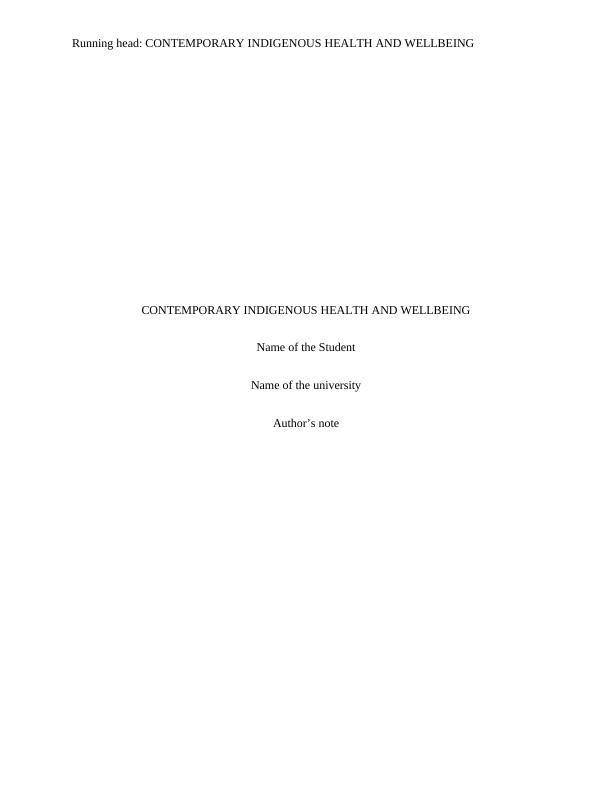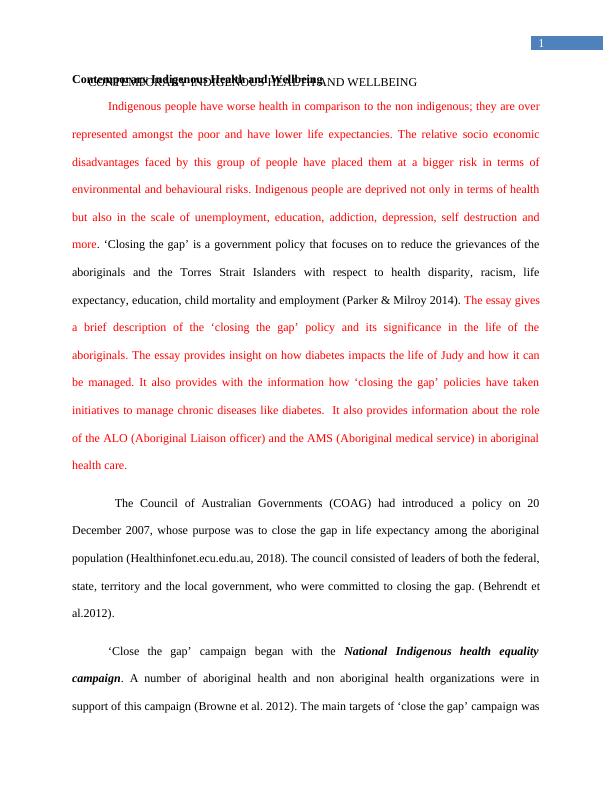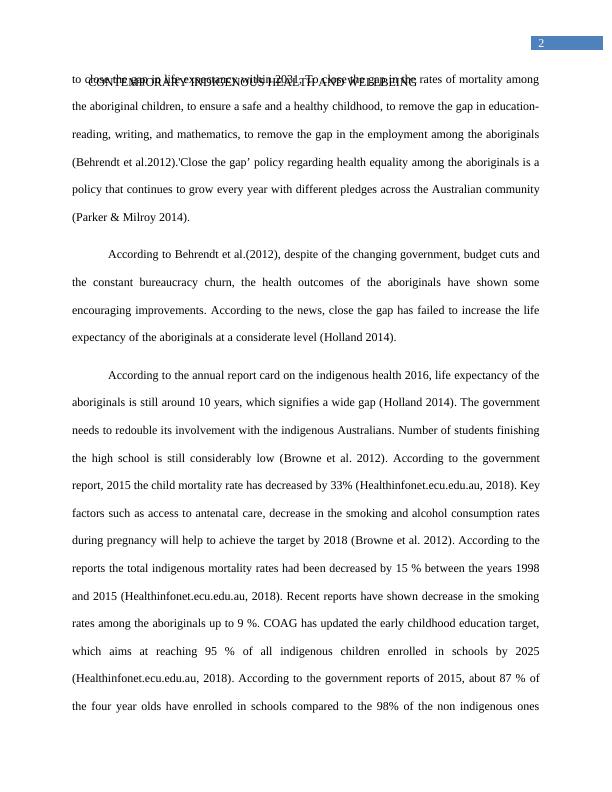Contemporary Indigenous Health and Wellbeing - DOC
9 Pages2554 Words138 Views
Added on 2020-05-28
Contemporary Indigenous Health and Wellbeing - DOC
Added on 2020-05-28
ShareRelated Documents
Running head: CONTEMPORARY INDIGENOUS HEALTH AND WELLBEINGCONTEMPORARY INDIGENOUS HEALTH AND WELLBEING Name of the StudentName of the universityAuthor’s note

1CONTEMPORARY INDIGENOUS HEALTH AND WELLBEINGContemporary Indigenous Health and WellbeingIndigenous people have worse health in comparison to the non indigenous; they are overrepresented amongst the poor and have lower life expectancies. The relative socio economicdisadvantages faced by this group of people have placed them at a bigger risk in terms ofenvironmental and behavioural risks. Indigenous people are deprived not only in terms of healthbut also in the scale of unemployment, education, addiction, depression, self destruction andmore. ‘Closing the gap’ is a government policy that focuses on to reduce the grievances of theaboriginals and the Torres Strait Islanders with respect to health disparity, racism, lifeexpectancy, education, child mortality and employment (Parker & Milroy 2014). The essay givesa brief description of the ‘closing the gap’ policy and its significance in the life of theaboriginals. The essay provides insight on how diabetes impacts the life of Judy and how it canbe managed. It also provides with the information how ‘closing the gap’ policies have takeninitiatives to manage chronic diseases like diabetes. It also provides information about the roleof the ALO (Aboriginal Liaison officer) and the AMS (Aboriginal medical service) in aboriginalhealth care. The Council of Australian Governments (COAG) had introduced a policy on 20December 2007, whose purpose was to close the gap in life expectancy among the aboriginalpopulation (Healthinfonet.ecu.edu.au, 2018). The council consisted of leaders of both the federal,state, territory and the local government, who were committed to closing the gap. (Behrendt etal.2012). ‘Close the gap’ campaign began with the National Indigenous health equalitycampaign. A number of aboriginal health and non aboriginal health organizations were insupport of this campaign (Browne et al. 2012). The main targets of ‘close the gap’ campaign was

2CONTEMPORARY INDIGENOUS HEALTH AND WELLBEINGto close the gap in life expectancy within 2031, To close the gap in the rates of mortality amongthe aboriginal children, to ensure a safe and a healthy childhood, to remove the gap in education-reading, writing, and mathematics, to remove the gap in the employment among the aboriginals(Behrendt et al.2012).'Close the gap’ policy regarding health equality among the aboriginals is apolicy that continues to grow every year with different pledges across the Australian community(Parker & Milroy 2014). According to Behrendt et al.(2012), despite of the changing government, budget cuts andthe constant bureaucracy churn, the health outcomes of the aboriginals have shown someencouraging improvements. According to the news, close the gap has failed to increase the lifeexpectancy of the aboriginals at a considerate level (Holland 2014). According to the annual report card on the indigenous health 2016, life expectancy of theaboriginals is still around 10 years, which signifies a wide gap (Holland 2014). The governmentneeds to redouble its involvement with the indigenous Australians. Number of students finishingthe high school is still considerably low (Browne et al. 2012). According to the governmentreport, 2015 the child mortality rate has decreased by 33% (Healthinfonet.ecu.edu.au, 2018). Keyfactors such as access to antenatal care, decrease in the smoking and alcohol consumption ratesduring pregnancy will help to achieve the target by 2018 (Browne et al. 2012). According to thereports the total indigenous mortality rates had been decreased by 15 % between the years 1998and 2015 (Healthinfonet.ecu.edu.au, 2018). Recent reports have shown decrease in the smokingrates among the aboriginals up to 9 %. COAG has updated the early childhood education target,which aims at reaching 95 % of all indigenous children enrolled in schools by 2025(Healthinfonet.ecu.edu.au, 2018). According to the government reports of 2015, about 87 % ofthe four year olds have enrolled in schools compared to the 98% of the non indigenous ones

End of preview
Want to access all the pages? Upload your documents or become a member.
Related Documents
Contemporary Indigenous Health and Well-being | Essaylg...
|8
|2220
|524
Close the Gap Policy in Australia: Challenges and Approacheslg...
|9
|2037
|245
Contemporary Indigenous Health and Wellbeing | Studylg...
|8
|2267
|15
Contemporary Indigenous Health And Wellbeing Report 2022lg...
|8
|2234
|15
Assignment on Indigenous People of Australia 2022lg...
|7
|2116
|33
Closing the Gap Policy and its Significance to Indigenous Australianslg...
|9
|2301
|364
